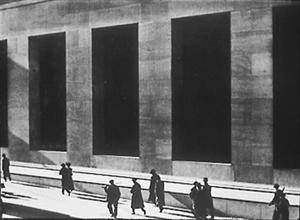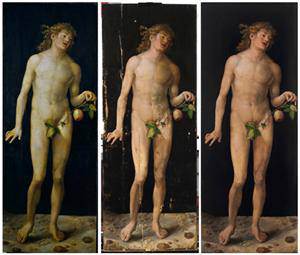
Paul Strand
Wall Street, 1915
Philadelphia Museum of Art acquires 3,000 works by Paul Strand The Museum has received as partial and promised gifts 1422 images from The Paul Strand Archive at the Aperture Foundation, as well as 566 master prints from Strand’s negatives by the artist Richard Benson]]>
November 18th, 2010, source: The Philadelphia Museum of Art
The Philadelphia Museum of Art announced that it has acquired, through several gifts and a purchase agreement with the Aperture Foundation, the core collection of photographs by Paul Strand, one of the pre-eminent photographers of the 20th century. Through the generosity of philanthropists Lynne and Harold Honickman, Marjorie and Jeffrey Honickman, and H.F. “Gerry” and Marguerite Lenfest, the Museum has received as partial and promised gifts 1422 images from The Paul Strand Archive at the Aperture Foundation, as well as 566 master prints from Strand’s negatives by the artist Richard Benson. The Museum has also entered into an agreement with the Aperture Foundation to purchase an additional 1276 photographs. As a whole, this acquisition comprises more than 3000 prints and lantern slides, including the finest examples of every image in the Archive. Together with other photographs by Strand already owned by the Museum, this acquisition makes the Philadelphia Museum of Art the world’s most important repository for the study of his work.
The portion of The Paul Strand Archive that the Museum has made a commitment to purchase from the Aperture Foundation includes many remarkable photographs. Among them are two of Strand’s rare gum bichromate prints, which date to the earliest years of his career. Also included are masterpiece platinum and silver portraits of his first wife, Rebecca Salsbury, and several other key portraits of his circle in the 1910s and 1920s, including his father Jacob, painter John Marin, and fellow photographer Kurt Baasch; unique prints such as a 1922 image of Constantin Brancusi’s sculpture Mlle. Pogany and a solarized portrait of the architect Henry Churchill (1922); major examples of his nature and machine abstractions, including the unique Rock, Georgetown, Maine (1927) and a rare pair of vintage platinum and silver prints of Fern, New England (1928); and superb prints from his early sojourns to the Gaspé Peninsula, the Southwest, and Mexico.
“Combined with the Museum’s existing holdings, this acquisition will give the Museum an unrivaled collection of Strand’s critical early work and his photographs of the Southwest and Mexico, all recognized as high points of his career,” commented Peter Barberie, the Museum’s Brodsky Curator of Photographs. “Added to the recent gifts to the Museum from the Honickmans and Lenfests, the acquisition will also enable us to assemble nearly complete sets of vintage prints from all of Strand’s later projects, beginning with his prized New England photographs of the 1940s and running through the final series he made in the garden of his home in Orgeval, France.”
The Paul Strand Collection will permit the study of Strand’s career with prints from the majority of his negatives, including most known variants and croppings of individual images. It will, moreover, enable the Museum to keep together several prints made from a single negative using different processes, at different times, and with different papers. As such, The Paul Strand Collection will be an essential resource for any scholar of 20th-century photography. In addition to 2,768 prints and lantern slides by Strand himself, the acquisition includes the gift of 566 gelatin silver and platinum prints from Strand’s negatives by the eminent American photographer Richard Benson, made for Aperture in the 1980s. Benson has printed Strand’s negatives since the early 1970s, when he worked closely with the artist. As part of its ongoing publishing initiatives, the Aperture Foundation will prepare a Paul Strand catalogue raisonne in cooperation with the Philadelphia Museum of Art.
Follow us on:


